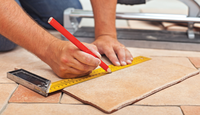Laying Tiles
Although sometimes awkward to use, tiling window managers are effective. X Tile can be used to expand a standard window manager with tiling functions, combining the best of both worlds.
|

Nagy-Bagoly Arpad, 123RF
Although sometimes awkward to use, tiling window managers are effective. X Tile can be used to expand a standard window manager with tiling functions, combining the best of both worlds.
Window managers are responsible for doing just what their name suggests: They administer windows on a desktop. Among many other tasks, this involves positioning windows on a virtual desktop
Window managers come mainly in two varieties. The majority only permit arbitrary positioning, or moving, of windows, which can easily lead to overlapping windows.
A tiling window manager works differently. It arranges windows so that, if possible, they do not sit on top of one another. The tiling manager does this by automatically adapting the size and the positioning, which results in better use of the desktop.
[...]
Pages: 4
The GNOME Project launches the new GNOME 3 website that brings you all the latest news about the new desktop of the same name.
Xfce 4.12 has been under development for almost three years and is now ready to take over for Xfce 4.10. This article looks at improvements found in version 4.12 and what the long release cycles mean for the user.
Opera changed course with version 15, giving up its status as independent software and dropping many of its features. Vivaldi seeks to offer a new home to fans of the old Opera.
The Inkscape vector graphics program not only lets you work with pencil and ink lines, it can help you mimic the elegant brushstrokes of an oil painting. Our three easy-to-follow examples show you how.
QupZilla is a new Linux web browser that enters in an already crowded arena. But, QupZilla holds its own when it comes to speed and ergonomics.
© 2026 Linux New Media USA, LLC – Legal Notice